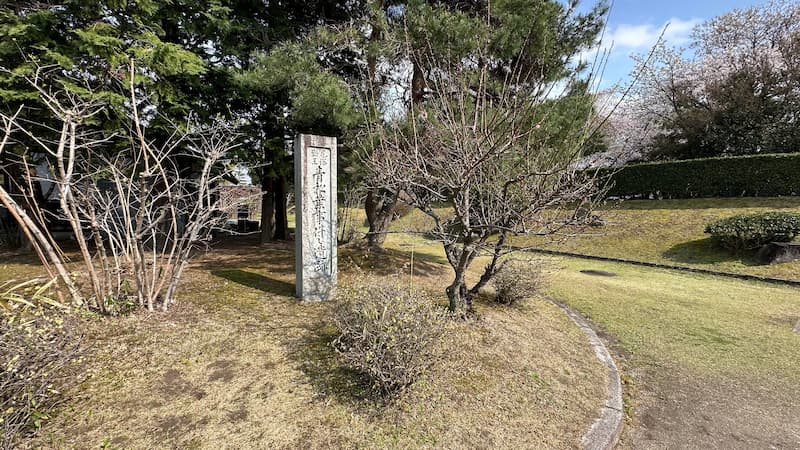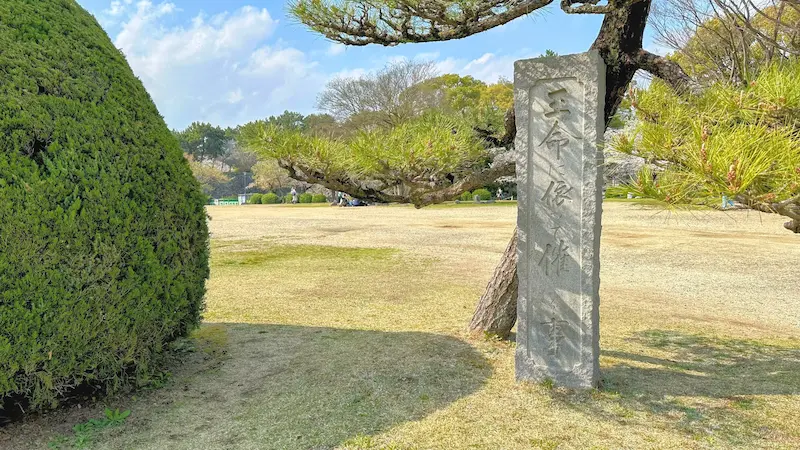Listen to the Stone Monuments That Echo Through History
Scattered throughout Nagoya Castle’s Ninomaru Garden are stone monuments and statues that quietly recount episodes from Japan’s past—like the “Site of the Aomatsuba Incident”, the “Han Kun Hiden Monument”, and the “Kiyomasa Stone-Pulling Statue” honoring castle-building master Katō Kiyomasa. Each marker carries messages that transcend time. By exploring these landmarks, you can uncover the inner workings of the Owari Domain and the behind-the-scenes stories of Nagoya Castle’s construction.
Site of the Aomatsuba Incident

🏛 Overview
The Aomatsuba Incident Monument, tucked quietly within Nagoya Castle, commemorates a political purge that occurred within the Owari Domain during the final days of the Tokugawa shogunate. In January 1868 (Keiō 4), Tokugawa Yoshikatsu, the 14th lord of the Owari Domain, executed 14 retainers aligned with the pro-shogunate faction and punished 20 others.
The incident, reflecting internal power struggles and conflict over how to respond to Japan’s new government, was named after Watanabe Shinzaemon Aritsuna, one of the executed samurai, whose poetic name “Aomatsuba” inspired the incident’s title. For more details, see local resources such as Nagoya Navi’s “Nagoya Castle Exploration #9 – The Aomatsuba Incident” or its corresponding Wikipedia entry.
Today, this stone monument preserves the memory of those turbulent times, silently conveying the tension and gravity of Owari’s political climate during the collapse of the Tokugawa regime.
🗺 Address:
1-1 Honmaru, Naka-ku, Nagoya, Aichi Prefecture, Ninomaru area
🚶 Access:
Approx. 1-minute walk (55m) from the Nagono Castle Ruins
⏳ Recommended Visit Duration:
- Quick Look: ~3 minutes
- In-Depth Visit: ~10 minutes
📍 Highlights:
🔹 Aomatsuba Incident Monument: A quietly placed stone monument behind the East Gate gift shop, marking a significant event in samurai history.
🔹 Han Kun Hiden Monument: Nearby stands another stone inscribed with the principles of the Owari Domain, written by its first lord, Tokugawa Yoshinao.
🔹 Seasonal Tip: In spring, the surrounding cherry blossoms create a peaceful, reflective atmosphere perfect for historical exploration.
📌 Trivia:
- Historical Insight: The incident exposed tensions between the pro-shogunate and pro-imperial factions within the domain, reflecting the complex political shifts of the era.
- Hidden Detail: This monument often doesn’t appear on official maps—check its location in advance.
- Famous Connections: Tokugawa Yoshikatsu, the man behind the purge, was the half-brother of Tokugawa Yoshinobu and is also known for his later work as a photographer.
Han Kun Hiden Monument(Secret Clan Precepts Monument)

🏛 Overview
The Han Kun Hiden Monument is inscribed with the phrase “Act According to the Emperor’s Command” from the closing of the Gunyō Gakan, a military treatise by Tokugawa Yoshinao, the first lord of the Owari Domain. This teaching was passed down as a core principle of the domain’s governance.
The inscription reflects the domain’s loyalty to the Emperor and foreshadows the Owari Domain’s eventual support of the new Meiji government during the Bakumatsu period. As a symbol of political philosophy, this stone prompts visitors to consider the deeper ideologies behind Japan’s transition from shogunate to imperial rule.
🗺 Address:
1-1 Honmaru, Naka-ku, Nagoya, Aichi Prefecture, Ninomaru Garden
🚶 Access:
Approx. 1-minute walk (50m) from the Aomatsuba Incident Monument
⏳ Recommended Visit Duration:
- Quick Look: ~3 minutes
- In-Depth Visit: ~10 minutes
📍 Highlights:
🔹 Han Kun Hiden Monument: A vital historical inscription representing the Owari Domain’s foundational ideals and dedication to imperial authority.
🔹 Ninomaru Garden: A beautiful, culturally designated space where nature and history meet.
🔹 Seasonal Tip: Cherry blossoms in spring and fiery foliage in autumn enhance the serenity of the monument’s setting.
📌 Trivia:
- Historical Insight: Yoshinao’s philosophy of absolute loyalty to the emperor heavily influenced the domain’s stance during the Meiji Restoration.
- Hidden Detail: This monument is often overlooked in official castle maps—be sure to locate it beforehand.
- Famous Connections: Tokugawa Yoshinao was the ninth son of Tokugawa Ieyasu and the founder of the Owari Tokugawa family.
Statue of Katō Kiyomasa Hauling Stones

🏛 Overview
Located within Ninomaru Garden, the Statue of Katō Kiyomasa Pulling Stones honors the legendary castle builder who played a major role in constructing Nagoya Castle. Known for his mastery of stonework, Katō Kiyomasa was said to have led the labor himself—standing atop giant stones and chanting to coordinate the movement of his workers.
The bronze statue recreates this iconic scene and offers a powerful image of leadership and craftsmanship. Another statue of Kiyomasa can also be found near the Honmaru East Ichinomon Gate, donated by the Nagoya Kita Lions Club in 1980.
🗺 Address:
1-1 Honmaru, Naka-ku, Nagoya, Aichi Prefecture, inside Ninomaru Garden
🚶 Access:
Approx. 2-minute walk (60m) from the Han Kun Hiden Monument
⏳ Recommended Visit Duration:
- Quick Look: ~5 minutes
- In-Depth Visit: ~10 minutes
📍 Highlights:
🔹 Kiyomasa Stone-Pulling Statue: A striking bronze depiction of Katō Kiyomasa leading the transport of massive stones during castle construction.
🔹 Ninomaru Garden: A scenic and tranquil space designated as a cultural site, perfect for peaceful reflection.
🔹 Seasonal Tip: The garden shines in all seasons—cherry blossoms in spring, vibrant foliage in autumn, and quiet snowscapes in winter.
📌 Trivia:
- Historical Insight: Kiyomasa was not only a general under Toyotomi Hideyoshi but also a master architect, known for commanding construction directly from the field.
- Hidden Detail: Nagoya Castle features other spots linked to Kiyomasa, including the famed “Kiyomasa Stone” embedded in the stone walls.
- Famous Connections: Revered as a military and architectural genius, Katō Kiyomasa left a lasting legacy in Japan’s fortress-building history.



comment